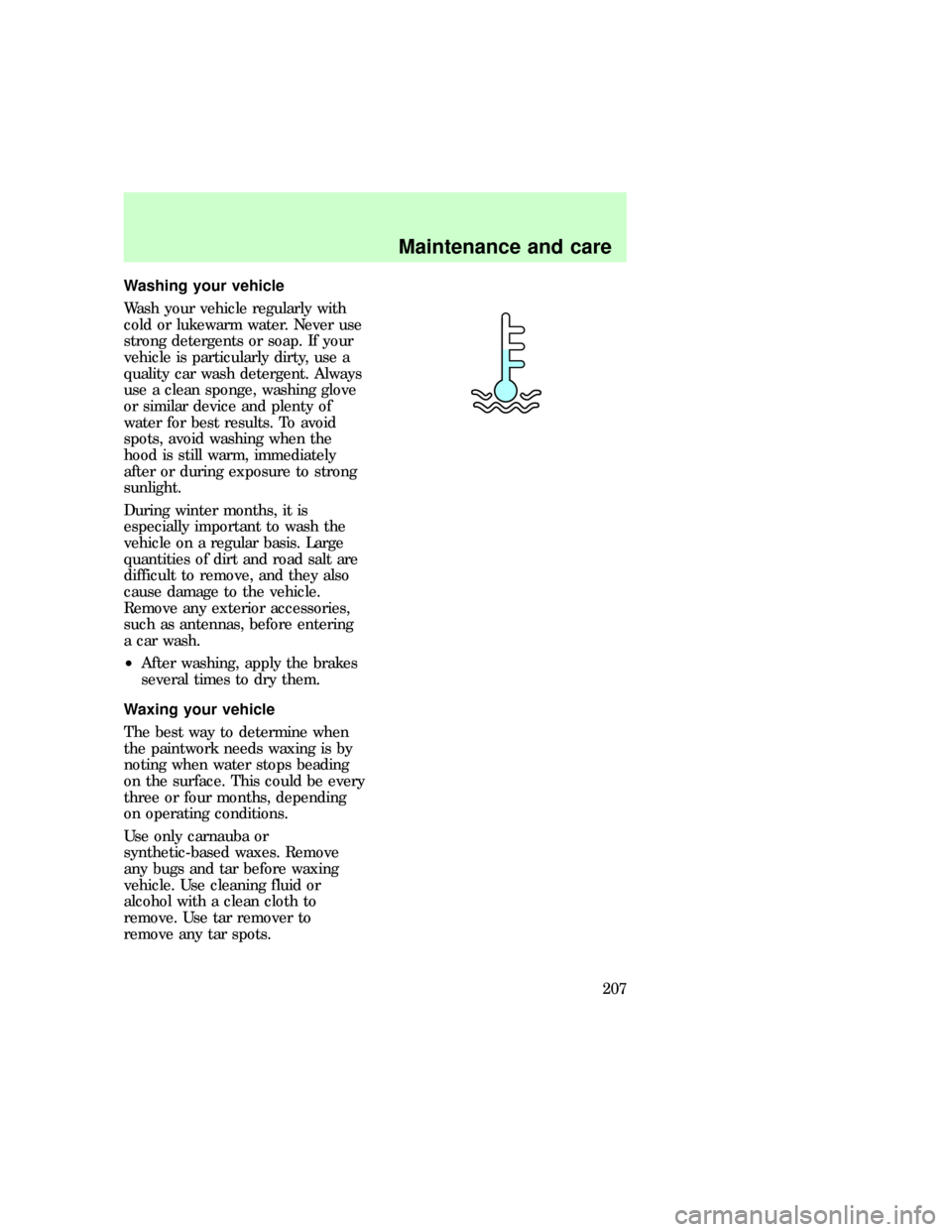Page 194 of 219
Do not park, idle, or drive
your vehicle in dry grass
or other dry ground cover. The
emission system heats up the
engine compartment and exhaust
system, which can start a fire.
If you smell exhaust fumes
inside your vehicle, have
your dealer inspect your vehicle
immediately. Do not drive if you
smell exhaust fumes.
On vehicles without
original equipment floor
covering or insulation, do not let
passengers ride in your truck in
a manner that allows contact
between skin and the metal floor.
If you notice one or more of the
following, the emissions system
may not be working properly. Have
your vehicle serviced as soon as
possible.
²Fluid leaks
²The
orCHECK
ENGINElights
illuminate in the instrument
cluster and remain lit
²Strange odors
²Engine runs more than five
seconds after shut-off or engine
misfires, surges, stalls or
backfires
²Loss of oil pressure.
f12_important_emissions_info
Maintenance and care
195
Page 205 of 219
Exterior bulb specifications
Function Number of
bulbsTrade number
Front park/turn lamps 2 3157NAK
Foglamps 2 9006
Headlamps 2 9007
Rear turn/sidemarker 2 3157NAK
AIMING HEADLAMPS
The alignment of your headlamps
should be checked if:
²Oncoming motorists frequently
signal you to turn off your
vehicle's high beams when you
do not have the high beams on.
²The headlamps do not seem to
give you enough light to see
clearly at night.
²The headlamp beams are
pointed substantially away from
a position slightly down and to
the right.
See your Ford dealer for precise
headlamp adjustment.
Cleaning and caring for your
vehicle
Refer to the ªCustomer Assistance
Guideº for a list of Ford-approved
cleaners, polishes and waxes.
f12_aiming_hlamps
f12_cleaning_your_vehicle
com_cleaning_caring.01
com_washing_vehicle.01
Maintenance and care
206
Page 206 of 219

Washing your vehicle
Wash your vehicle regularly with
cold or lukewarm water. Never use
strong detergents or soap. If your
vehicle is particularly dirty, use a
quality car wash detergent. Always
use a clean sponge, washing glove
or similar device and plenty of
water for best results. To avoid
spots, avoid washing when the
hood is still warm, immediately
after or during exposure to strong
sunlight.
During winter months, it is
especially important to wash the
vehicle on a regular basis. Large
quantities of dirt and road salt are
difficult to remove, and they also
cause damage to the vehicle.
Remove any exterior accessories,
such as antennas, before entering
a car wash.
²After washing, apply the brakes
several times to dry them.
Waxing your vehicle
The best way to determine when
the paintwork needs waxing is by
noting when water stops beading
on the surface. This could be every
three or four months, depending
on operating conditions.
Use only carnauba or
synthetic-based waxes. Remove
any bugs and tar before waxing
vehicle. Use cleaning fluid or
alcohol with a clean cloth to
remove. Use tar remover to
remove any tar spots.
com_waxing_vehicle.01
com_repairing_chips
Maintenance and care
207
Page 208 of 219
dirt buildup act as insulators and
keep the engine warmer than
normal. Follow these guidelines to
clean your engine:
²Take care when using a power
washer to clean the engine. The
high pressure fluid could
penetrate the sealed parts and
cause damage.
²Do not spray with cold water to
avoid cracking the engine block.
²Cover the highlighted areas to
prevent water damage when
cleaning the engine.
²Never wash or rinse the engine
while it is running; water in the
running engine may cause
internal damage.
Cleaning plastic exterior parts
Use a vinyl cleaner for routine
cleaning of plastic. Clean with a tar
remover if necessary. Do not clean
com_plastic_exterior.01
Maintenance and care
209